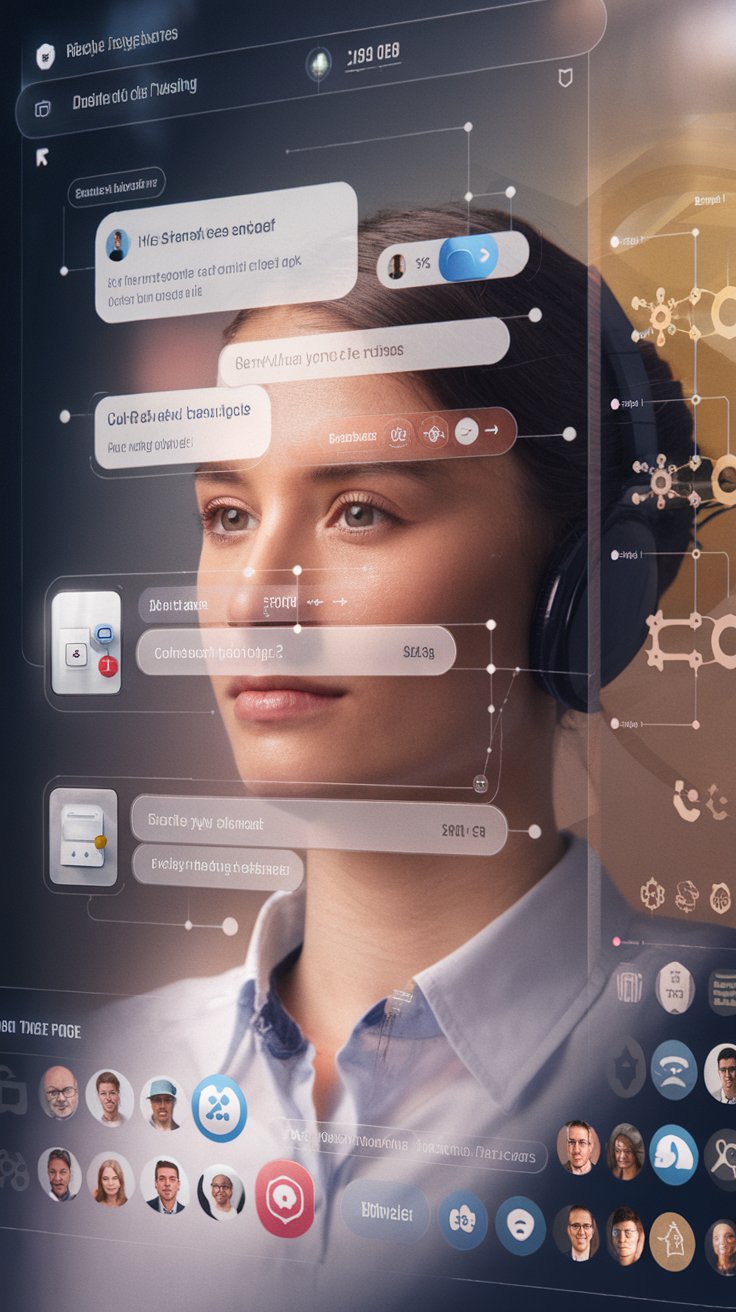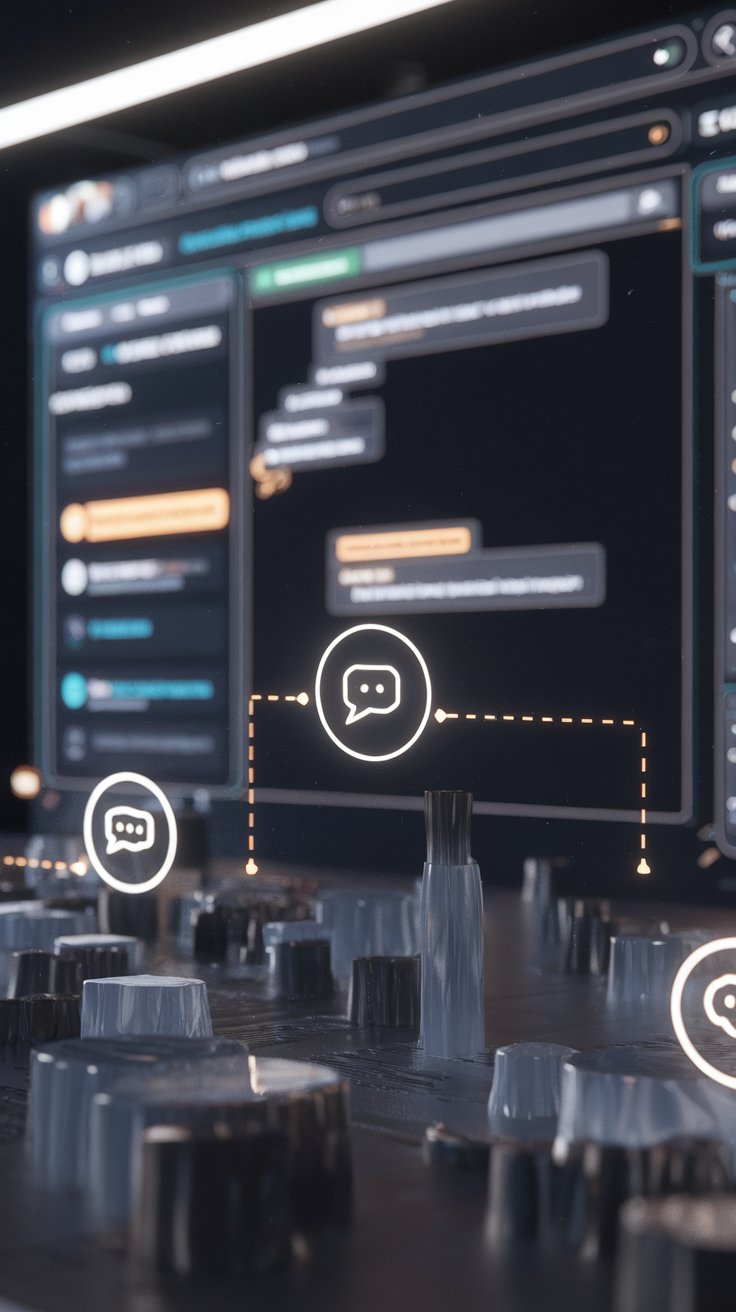Introduction
In an era where customer engagement defines business success, leveraging chat optimization for a website chat widget has emerged as a game-changing strategy. Chat optimization involves refining the way chat interactions happen with website visitors, ensuring that each conversation is productive and capable of driving results. By enhancing user experience, businesses can foster stronger relationships with customers, leading to increased satisfaction and loyalty. This article delves into the critical elements of chat optimization, exploring techniques that drive engagement.
From understanding the nuances of chatbot functionality to implementing strategic messaging, this article explores various chapters to provide a comprehensive guide for businesses looking to enhance their chat systems. Optimizing a chat widget is not just about answering questions; it’s about creating meaningful interactions that convert visitors into customers. Join us as we explore the intricate facets of chat optimization that can significantly impact your website’s performance.
Understanding Chat Optimization Enhancing Customer Experience Through Effective Engagement
Chat optimization refers to the strategies and techniques employed to enhance the effectiveness and experience of chat interactions on websites. This concept is vital for businesses seeking to improve customer service and drive conversions. By optimizing chat functions, companies can provide users with timely responses, relevant information, and an engaging interface that promotes interaction. The primary goals are to increase engagement, reduce response times, and ultimately, boost conversion rates.
The importance of chat optimization cannot be overstated. In an age where consumers demand immediate support, having an optimized chat feature not only meets their expectations but also creates a more personalized experience. A well-organized chat system can distinguish a brand from its competitors, as customers are more likely to return to a site that fulfills their needs swiftly and effectively. Moreover, a significant number of customers expect to have real-time communication options when interacting with businesses. If these needs are unmet, there is a high chance of losing potential sales and damaging customer loyalty.
Effective chat optimization influences customer experience by ensuring smoother interactions. It involves understanding customer queries, anticipating their needs, and providing solutions in a user-friendly manner. Utilizing tools such as automated responses, integrated chatbots, and personalized messaging can significantly enhance the user experience. Each interaction must be designed to guide customers toward their desired outcomes, whether that be a purchase, sign-up, or acquiring more information.
The ability to analyze chat interactions is a good practice for continuous improvement. Businesses can gather insights from customer conversations and adapt their chat strategies accordingly. By evaluating common questions, response times, and user satisfaction, companies can refine their approach, ensuring that their chat services evolve with changing customer expectations. This level of adaptability is key to maintaining relevance and maximizing the effectiveness of website chat widgets.
Chat optimization is a foundational element for enhancing customer experience and driving results. By prioritizing this aspect of customer interaction, businesses can create lasting relationships, improve service efficiency, and ultimately, increase their conversion rates.
The Role of Free Website Chat Widgets Enhancing Customer Service Across Various Industries
Free website chat widgets have gained significant traction among businesses striving to enhance customer service. These tools function as integrated communication platforms, providing real-time support and connecting customers directly to service representatives. The operational simplicity and cost-effectiveness of these chat widgets contribute to their widespread adoption across various sectors, including e-commerce, healthcare, education, and more.
When a visitor lands on a website and sees a chat widget, they are often greeted with an inviting interface. These widgets allow customers to initiate conversations seamlessly without the need to navigate through multiple web pages or wait for email responses. By clicking the chat icon, customers can engage instantly, fostering an environment of immediacy that is increasingly demanded in today’s service landscape.
In e-commerce, for instance, these chat widgets play a pivotal role in guiding potential customers through the purchasing process. They provide answers to product inquiries, help with order tracking, and assist in resolving payment issues. As a result, businesses can expect to see improved engagement metrics and higher conversion rates. Similarly, in the healthcare industry, chat widgets serve to enhance patient interaction by streamlining appointment bookings, answering insurance inquiries, and facilitating quick access to medical advice, all of which significantly improve patient satisfaction.
An essential aspect of free chat widgets is the analytics they offer. Businesses can track visitor interactions, monitor chat volumes, and gauge customer sentiment through these tools. This data allows organizations to refine their customer service strategies and implement enhancements that cater to their audience’s needs. For example, if analytics reveal that customers frequently ask about a specific product, businesses can adjust their FAQs or provide additional training for their support staff.
The versatility of chat widgets further extends to their integration with various customer relationship management (CRM) systems. This connection enables businesses to maintain comprehensive records of customer interactions, which are invaluable for personalizing future communication and marketing efforts. Thus, free website chat widgets not only facilitate immediate support but also contribute to broader customer relationship strategies, ensuring that businesses remain competitive in their respective fields.
Free website chat widgets serve as vital tools for enhancing customer service across numerous industries. Their capacity to provide real-time assistance, coupled with valuable insights through analytics, empowers businesses to maximize engagement and improve overall customer experiences.
Strategies for Effective Chat Conversations Engaging Visitors to Drive Results
Optimizing Chat for Higher Engagement and Conversion
Effective chat conversations can significantly influence a visitor’s decision-making process, ultimately boosting engagement and conversion rates. To achieve this, businesses must adopt targeted strategies that facilitate meaningful interactions. One of the first steps is to ensure that the chat widget is readily accessible on key pages of the website. Consider implementing proactive chat invitations that trigger based on user behavior, such as time spent on a page or scrolling patterns. This strategy not only welcomes visitors but also encourages them to engage rather than waiting for them to initiate the conversation.
Another strategy for optimizing chat interactions is personalizing user engagement based on the data collected from previous interactions. This may include addressing visitors by name, referencing their previous inquiries, or guiding them based on their browsing history. Personalization helps establish a rapport and makes the user feel valued rather than just another visitor. Additionally, ensuring the chat interface is user-friendly and visually appealing can contribute to a positive experience, encouraging visitors to express their needs and concerns freely.
Leveraging Knowledge Bases and Training Chat Agents
Integrating a robust knowledge base within the chat system can enhance the effectiveness of chat conversations. By providing chat agents with easy access to resources, they can deliver quick and accurate responses to customer queries. Investing time in training chat agents to not only understand the product or service thoroughly but also to adopt a conversational tone can have a tremendous impact. Agents should be trained to listen actively and ask clarifying questions to better understand visitor needs, which promotes a two-way dialogue rather than a mere transactional exchange.
Maintaining a balance between automated responses and human intervention is essential. While automated replies can efficiently handle simple inquiries, offering the option to escalate to a human representative for more complex issues can significantly enhance user satisfaction. Establishing clear hand-off strategies ensures the conversation is fluid, preventing potential frustration caused by repeating information.
By focusing on these strategies, businesses can foster engaging chat conversations that not only drive interactions but also lead to higher conversion rates. This comprehensive approach maximizes the potential of free website chat widgets, making them a pivotal tool in modern customer service frameworks.
Measuring Chat Performance Key Metrics for Business Objectives
Understanding the Impact of Chat Interactions
Effectively measuring the performance of chat interactions is vital for any business looking to drive results through a free website chat widget. Defining key metrics enables businesses to assess the effectiveness of their chat optimization strategies in contributing to overarching goals, such as increasing conversion rates and enhancing customer engagement. Metrics such as chat volume, response time, resolution rate, and customer satisfaction (CSAT) provide a clear view of the chat’s impact within the broader context of business objectives.
Key Metrics for Evaluation
Several metrics stand out when evaluating chat performance:
- Chat Volume: This indicates the number of interactions taking place within a set time frame. A high chat volume often reflects growing interest or traffic to the website, highlighting the effectiveness of marketing efforts.
- Average Response Time: Measuring how quickly agents respond to inquiries is crucial for customer satisfaction. Short response times often lead to higher engagement rates, as users are less likely to abandon the chat experience due to delays.
- First Contact Resolution (FCR): This metric tracks the percentage of chats resolved on the first interaction. Higher FCR rates correlate with improved customer satisfaction and loyalty, since users value efficient support.
- Conversion Rate: This measures the percentage of chat interactions that result in a desired action, such as completing a purchase or signing up for a newsletter. This is critical for evaluating how effectively chat interactions are driving business objectives.
- Customer Satisfaction Score (CSAT): Post-chat surveys can gauge user satisfaction directly. High scores indicate successful interactions, while lower scores can highlight areas needing improvement.
Tracking these metrics enables businesses to identify strengths and weaknesses in their chat strategies. For example, if the conversion rate is low despite high chat volume, it may signal a need for improved chat techniques or further training for support agents. In contrast, rapid response times alongside high resolution rates might indicate a well-optimized chat function that enhances user experience.
The relevance of these metrics extends beyond individual chat interactions by contributing to the overall assessment of business performance. Integrating these measures into regular reporting practices solidifies their role in strategic decision-making, establishing chat as a critical component of customer engagement and satisfaction initiatives.
Integrating Chatbots into the Strategy Enhancing User Experience with Chat Optimization
In chat optimization, the integration of chatbots represents a significant step towards creating an engaging and efficient user experience. Chatbots serve as the first line of interaction on a website, equipped with the ability to respond swiftly to user inquiries and provide personalized support. This immediate engagement can lead to a considerable boost in conversion rates. In order to leverage their full potential, businesses must strategically incorporate chatbots into their overall chat optimization efforts.
Harnessing the Power of Chatbots for Personalized Experiences
One of the standout features of chatbots is their ability to deliver personalized interactions based on user behavior and data. By employing machine learning algorithms, chatbots can analyze past interactions, preferences, and context-driven prompts to tailor their responses. This means that instead of a generic interaction, users receive targeted communication that resonates with their specific needs, enhancing their overall experience. For businesses, this translates into a more meaningful dialogue that nurtures user interest and fosters loyalty.
Chatbots can manage multiple conversations simultaneously, ensuring that no user feels neglected. This scalability is especially beneficial during peak traffic periods, where human agents may struggle to keep up. The efficiency afforded by chatbots not only streamlines operations but also encourages users to engage more robustly, thus driving results in terms of both engagement and conversion.
Seamless Integration into Existing Workflows
Integrating chatbots into a website’s existing communication workflow requires thoughtful planning. Ensuring that chatbots work in conjunction with human agents can enhance service quality. Setting up a framework where chatbots handle routine inquiries while human representatives tackle complex issues can optimize resource allocation. This strategic collaboration ensures that users receive prompt answers to their inquiries while still having access to personalized assistance when needed.
Utilizing chatbots as part of a broader chat optimization strategy allows for constant monitoring of interaction patterns and preferences. This data can inform future improvements to chatbot functionality, ensuring they evolve alongside user expectations. Creating feedback loops between chatbots and traditional support channels can provide valuable insights that inform ongoing optimization efforts, reinforcing the chatbot’s role as a key player in enhancing user experience.
Incorporating chatbots into chat optimization strategies is not merely about automating responses. It is about creating an interaction ecosystem that prioritizes user needs, ultimately driving results and achieving business objectives. As businesses adapt their strategies based on user feedback and performance metrics, they will bolster the value of their website chat widgets and achieve higher engagement levels.
Adapting to User Feedback A Key Component of Chat Optimization
Understanding the Value of User Insights
User feedback serves as a cornerstone of effective chat optimization. It provides businesses with direct insights into customer preferences, expectations, and pain points, all of which are vital for enhancing engagement through chat. When users interact with chat widgets, their experiences, whether positive or negative, can reveal much about how well these systems operate. Listening to and integrating this feedback can significantly drive results, leading to higher engagement and conversion rates.
Engaging with users post-interaction, whether through surveys or follow-up inquiries, allows for a nuanced understanding of their experiences. This feedback loop enables companies to refine dialogues, update response patterns, and improve overall service quality, ensuring that the chat widget evolves in response to real-world usage. The importance of capturing not only what works well but also what frustrates users cannot be understated. By addressing these concerns promptly, organizations can foster a stronger relationship with their clientele.
Continuous Improvement Through Analysis
Implementing a systematic approach to analyze user feedback can be transformative. Businesses can categorize feedback into actionable insights, identifying trends that signal both strengths and weaknesses. For example, if multiple users express difficulty in finding information, it may indicate that certain prompts and responses require adjustment. By actively monitoring conversations, organizations can pinpoint recurring themes that require attention, positioning themselves to enhance the user experience over time.
Adapting chat scripts based on user input can lead to more personalized interactions. For instance, if certain phrases resonate well or if specific questions frequently arise, incorporating these elements into the chat can make it feel more relevant and user-friendly. This level of customization not only boosts satisfaction but can also lead to higher conversion rates as users feel more connected to the service provided.
The continuous cycle of collecting feedback, analyzing data, and implementing improvements creates a dynamic chat system that grows with its audience. This approach manifests in various forms, from adjusting language and tone to refining response times—all of which contribute to a more engaged customer base.
As organizations look toward the future, the ability to adapt to user feedback will remain a pivotal aspect of chat optimization. Businesses that embrace this feedback-centric mindset can ensure their chat widgets evolve in ways that meet user expectations, fostering loyalty and driving results.
Future Trends in Chat Optimization Strategies for Enhanced Engagement
The landscape of chat optimization is rapidly evolving, and businesses must stay ahead of the curve to maximize engagement and conversion rates. One prominent trend is the integration of artificial intelligence and machine learning algorithms into chat systems. These advanced technologies enable chatbots to learn from interactions and continuously improve their responses, creating a more personalized and efficient user experience. For example, intelligent chat solutions can analyze past conversations to understand user preferences and tailor their responses accordingly, leading to higher satisfaction rates.
Another emerging trend is the shift towards omnichannel communication. Customers expect seamless interactions across various platforms, whether it’s through social media, messaging apps, or websites. Businesses that invest in an optimized chat widget capable of engaging users across these channels will likely see significant increases in engagement and conversions. This omnichannel approach eliminates friction, allowing customers to transition smoothly between platforms while maintaining consistent messaging.
Voice-activated technology is also gaining momentum in chat optimization. As voice assistants become ubiquitous, customers are increasingly expecting chat systems to incorporate voice interactions. Implementing voice recognition into chat solutions can streamline user experiences, making the chat interface more accessible and efficient. Businesses should explore how voice-activated chat functions can complement traditional text-based interactions to cater to a wider audience.
There is a growing emphasis on proactive chat strategies. Instead of waiting for users to initiate a conversation, businesses are leveraging automated prompts and intelligent triggers to engage users at critical moments. For instance, if a potential customer lingers on a product page for too long, an automated chat prompt can emerge to offer assistance or provide additional information, effectively reducing bounce rates and fostering engagement.
Data analytics will play an increasingly vital role in chat optimization. By closely monitoring user interactions and analyzing chat engagement metrics, businesses can identify trends, pinpoint areas for improvement, and refine their strategies. Implementing robust analytics tools will empower organizations to make data-driven decisions, ensuring that chat systems evolve in alignment with customer needs and expectations.
By staying attuned to these future trends in chat optimization, businesses can not only enhance their engagement and conversion rates but also secure a competitive edge in an ever-changing digital marketplace.
Conclusions
Chat optimization is a vital component for businesses aiming to enhance customer interactions and overall satisfaction. By employing effective strategies, such as personalizing user interactions and utilizing real-time analytics, companies can create a more engaging experience that resonates with visitors. The insights gained from optimizing chat widgets can lead to improved conversion rates and higher customer retention.
As we navigate the future of digital interactions, integrating chat optimization into business strategies will be essential. By prioritizing these practices, organizations can not only meet customer expectations but exceed them, ultimately driving greater profitability and growth. Embrace the tools and techniques outlined in this article to unlock the full potential of your website chat widget and transform your customer engagement strategy.




















